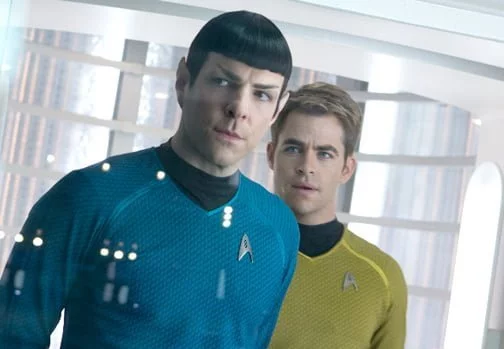
Zachary Quinto as Spock, left, and Chris Pine as Capt. James T. Kirk boldly go once again in the second J.J. Abrams’ film of the franchise, titled “Star Trek: Into Darkness.”
By Susan JAMES
Arguably one of the best series reboots in movie history, J. J. Abrams’ second installment of the new Star Trek prequel saga, “Star Trek: Into Darkness,” is a worthy addition to its predecessor. Cleverly written and fast-paced, with excellent CGI riffs on actual space photography, Captain Kirk and his intrepid crew make going boldly where no one has gone before a genuine adventure.
The foundation of Abrams’ revival/homage, which worked so well in the first film and continues to reap rewards here, is the casting. Chris Pine channels William Shatner’s Kirk without parodying him – not always an easy feat. Zachary Quinto’s Spock is spot on and the bromance between these two, the heart versus head tension, is the core from which the story operates. Spock may love Uhura; Kirk may be a space stud for the ages, but the person each relies on most is the other. Fortunately for the movie, they are supported by a stellar cast.
The British acting establishment has in recent years been the go-to place for fascinating villains. Think Alan Rickman, Tom Hiddleston and Ben Kingsley. They seem to do villainy better than anyone else. Maybe it’s all that Shakespeare or maybe it’s because they understand that a good villain requires convincing and, yes, sympathetic, motivation. Enter Benedict Cumberbatch, BBC’s superlative Sherlock Holmes. With his boyish good looks, he seems to mock the boyishly good-looking Kirk but where Kirk blazes, Cumberbatch’s John Harrison is cold as an ice planet.
Cumberbatch plays a Star Fleet undercover operative, “one of our own” who has gone rogue. His backstory is part of the mystery that Kirk and crew must unravel. During a council of war at Star Fleet headquarters (adroitly doubled by the Getty Institute in Westwood), Harrison launches an all-out air assault. High-level officers are killed, including Kirk’s mentor Christopher Pike (an effective Bruce Greenwood), and Kirk is tasked with taking Harrison down. The job is tricky as Harrison has escaped to an uninhabited zone on a planet inside the Klingon Empire. To get the job done, the Enterprise is equipped with a new type of photon torpedo. Kirk is ordered to go in, blow Harrison away and get out without the Klingons noticing, but Kirk as always has his own agenda.
One of the genius things about this movie are the numerous nods to the original TV show, including familiar character tics, quotable dialogue and even whole episodes, ‘The Trouble with Tribbles,” for instance. But the story is more than nostalgia and Abrams and his writers have added strands of contemporary relevance by incorporating echoes of the controversy over drone strikes and the fall-out from unprovoked military aggression. This may be a movie about war, but Abrams likes to remind us that the original mission of the Enterprise was exploration and peace.
The movie opens with a perfectly presented story within a story. British actor Noel Clarke (Mickey Smith for those who watch “Dr. Who”) lives in London with his Indian wife, works in a secret underground installation, and has a beloved only child lying in a coma in a local hospital. A stranger (Harrison) appears at her bedside and says one line: “I can save her.” We know there will be a price and we know the desperate father will pay it.
In a few elegant cuts, with only one line of dialogue, Abrams has given us the burning fuse for the next two hours of explosive excitement. You can’t ask any more from a filmmaker than that.
See you at the movies!
